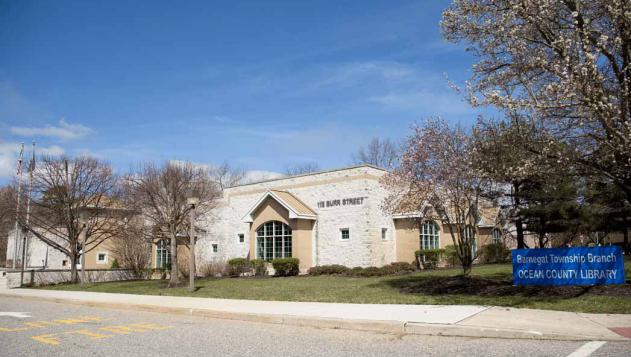Barnegat’s earliest known inhabitants were members of the Lenni-Lenape nation. Members of the Lenape would come to the coast in the spring to hunt, fish, and gather other food supplies in preparation for a winter spent inland. Travels to the coast decreased as European settlers arrived; eventually native inhabitants were relocated to reservations.
The name “Barnegat” was derived from the name given to the Barnegat Inlet by early 17th century Dutch explorers. It was identified as “Barende-gat,” meaning “inlet with breakers or troubled waters.” The Barnegat proved to be a lifeline for the community for centuries to come.
Europeans, primarily Quakers, began arriving in Barnegat in the early 1700s. The first recorded arrival was of Jonas Tow in 1705 who settled in the bay meadows along the water’s edge, eventually building a house in 1720. Descendants of the Birdsall, Mott, and Collins families, also early settlers, still reside in the area. Timothy Ridgeway and Sarah Cranmer were among Barnegat’s early settlers. Timothy Ridgeway and Levi Cranmer made the first recorded purchase of land in the area, with a portion of the land set aside for the building of the Barnegat Meeting House in 1767.
Barnegat’s economy developed from industries based in and around the bay. Many residents were whalers or built whaling boats, many whalers turned to smuggling and privateering of British supply ships during the off season; shipbuilding was also a large part of the local economy until the mid-1800s. A number of salt works were developed along the bay by the Quakers. The salt works were destroyed during the Revolutionary War, by both the British and the Patriots for differing reasons. After the Revolution, Barnegat became a major port. Roads were developed to provide better access for raw materials needed for a growing shipbuilding industry. For most of the 19th century Barnegat was a thriving village due to its natural resources, shipping, and shipbuilding. By the 1830s, there were 50 dwellings, three taverns, and four stores, making it one of the largest communities in present day Ocean County.
As local raw materials begin to diminish, reducing shipbuilding, many seamen turned to the transportation of goods from New York and Boston to the South. Many sea captains chose to settle in Barnegat and brought new wealth to the area with profits acquired during the Civil War. After the war, Barnegat became a popular summer resort area with several large inns, two railroad stations, and a department store.
Barnegat was a thriving community in the early 1900s, serving as a dominate shopping center. The only other shopping centers and banks were located in Toms River and Tuckerton. Train stations provided service to New York, Philadelphia, and Long Beach Island. And students from Manahawkin, Waretown, and Long Beach Island traveled by train or boat to Barnegat to attend Barnegat High School.
Industry in the early 1900s included the Barnegat Glass Company, the only glass factory ever operated in Ocean County. The Barnegat Glass Company, which manufactured green glass bottles, brought many workers to the area until it closed in 1914. Another flourishing business was the Perrine Sneakbox building business.
Joseph Howard Perrine’s assistant and successor, Alan Chadwick, redesigned the sneakbox into a racing boat until fiberglass replaced wood. Chadwick then turned to sail making and became one of the nation’s leading designers and makers of sails for “character boats.” Additional historic industries in town include a sawmill, tannery, and the export of salt hay, moss, peat, huckleberries, and cranberries.
Barnegat’s greatest growth came prior to World War I, serving as the main railroad terminal for the Tuckerton, Jersey Central, and New York railroads. The development of the Jersey shore before World War II passed Barnegat due to a lack of sufficient upland bay areas. The next building boom to occur was the late 1960s and early 1970s when developers noticed the potential of the area.
The settlement of African-American communities within Barnegat is not well documented. The first settlers were thought to be sharecroppers who moved into the area after the Civil War. More settlers came for job opportunities around World War I. And as Long Beach Island was developed as a resort destination, some African-Americans were displaced from small farms. The first documented African-American community was in Rose Hill, where the Barnegat Hill Cemetery was established in 1924. A second community developed on Gunning River Road, where Mt. Zion Church was established in 1932. Historically, there have been few recorded incidents of racial discord in the town. In 1979, when a Ku Klux Klan rally was planned in the community to show support for David Duke, 29 Klansmen showed up; they were met by more than 200 anti-Klan demonstrators both black and white. Some of the older, established black families have moved to new areas; however, new families of African-American, Hispanic, and other ethnic backgrounds have begun to settle in the community.
Many early Barnegat settlements such as Cedar Bridge, Reevestown, and Rose Hill have all but vanished and many new ones have developed in the township. Despite rapid growth, much of the historical past has been retained. Many 18th and 19th century homes and businesses are still standing and in use. The Barnegat Historical Society created a Heritage Village on East Bay Avenue consisting of four major buildings and three smaller structures – the Lippincott-Faulkenburg House, the Barber Shop, the Edwards House, the Butcher Shop, a corn crib, a motel cabin, and a three-hole necessary.
Barnegat has been a township since 1864 when it was established by an act to separate it from Stafford and Dover Townships, which were still part of Monmouth County. Barnegat was officially known as Union Township until 1978; the township gave out bumper stickers at the time stating “Union Township is now Barnegat, Ocean County.” Barnegat continues to be a rapidly growing community, but retains a commitment to preserving its local history and natural resources, including the Barnegat Bay.



